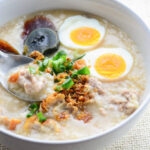Cashew chicken stir-fry is a delightful fusion of tender chicken pieces, crunchy cashew nuts, and vibrant vegetables, all brought together in a savory and flavorful sauce. This dish originates from Chinese cuisine and has become a beloved favorite in many parts of the world for its satisfying combination of textures and tastes. With its quick preparation and versatile ingredients, cashew chicken stir-fry is a perfect choice for a delicious and nutritious meal that can be enjoyed any day of the week.
| Ingredients | |
| 1 | 1 lb (450g) boneless, skinless chicken breasts, cut into bite-sized pieces |
| 2 | 1 cup (150g) cashew nuts |
| 3 | 1 bell pepper, sliced |
| 4 | 1 onion, sliced |
| 5 | 2 cloves garlic, minced |
| 6 | 1-inch piece of ginger, minced |
| 7 | 2 tablespoons soy sauce |
| 8 | 1 tablespoon oyster sauce |
| 9 | 1 tablespoon hoisin sauce |
| 10 | 1 teaspoon sesame oil |
| 11 | 1 teaspoon cornstarch |
| 12 | Salt and pepper to taste |
| 13 | Vegetable oil for stir-frying |
| 14 | Cooked rice, for serving |
Step-by-step cooking instruction of Cashew Chicken Stir-Fry:
Step-1 In a small bowl, mix together the soy sauce, oyster sauce, hoisin sauce, sesame oil, and cornstarch. Set aside.
Step-2 Over high heat, preheat a wok or large skillet. Add a tablespoon of vegetable oil.
Step-3 Add the chicken pieces to the wok and stir-fry until they are cooked through and lightly browned. After taking the chicken out of the skillet, set it aside.
Step-4 In the same wok, add a little more oil if needed, then add the minced garlic and ginger. Stir-fry until aromatic, about 30 seconds.
Step-5 Add the sliced onion and bell pepper to the wok and stir-fry for 2-3 minutes until they start to soften.
Step-6 Return the cooked chicken to the wok and add the cashew nuts.
Step-7 Pour the sauce mixture over the chicken and vegetables. Stir-fry for another 1-2 minutes until everything is well coated and heated through.
Step-8 Taste and adjust seasoning with salt and pepper if needed.
Step-9 Serve the cashew chicken stir-fry hot over cooked rice.
Nutritional values of Cashew Chicken Stir-Fry:
The nutritional values of cashew chicken stir-fry can vary depending on factors such as portion size, specific ingredients used, and cooking methods. However, here’s a general overview of the nutritional components:
| 1 | Protein: Chicken is a primary source of protein in this dish, providing essential amino acids necessary for muscle repair and growth. |
| 2 | Healthy Fats: Cashew nuts contribute healthy fats, including monounsaturated and polyunsaturated fats, which are beneficial for heart health and nutrient absorption. |
| 3 | Carbohydrates: Vegetables such as bell peppers and onions add carbohydrates, fiber, and essential vitamins and minerals. |
| 4 | Vitamins and Minerals: The stir-fry vegetables can provide a range of vitamins and minerals, including vitamin C, vitamin A, potassium, and folate. |
| 5 | Calories: The calorie content of cashew chicken stir-fry can vary but is generally moderate, making it a satisfying meal option. |
| 6 | Sodium: The sodium content may be higher depending on the amount of soy sauce and other salty seasonings used in the dish. |
| 7 | Added Sugars: Depending on the sauce ingredients, there may be added sugars, but this can be controlled by using low-sugar or homemade sauces. |
Background History of Cashew Chicken Stir-Fry
Cashew chicken stir-fry is a dish that has its roots in Chinese cuisine but has evolved over time, particularly in Western countries where it has become a popular menu item in Chinese restaurants. While the exact origins of the dish are not definitively documented, there are some historical contexts and influences that likely contributed to its development.
Chinese Culinary Traditions: Stir-frying is a traditional Chinese cooking technique that dates back centuries. Chinese cuisine emphasizes the use of fresh ingredients, quick cooking methods, and a balance of flavors and textures. Cashew chicken stir-fry embodies these principles, incorporating tender chicken, crunchy cashew nuts, and colorful vegetables stir-fried in a savory sauce.
Migration and Cultural Exchange: Chinese immigrants brought their culinary traditions with them as they migrated to other parts of the world, including the United States. In the late 19th and early 20th centuries, Chinese immigrants settled in various regions, establishing Chinese communities and restaurants. As they adapted their recipes to suit local tastes and ingredient availability, new dishes like cashew chicken stir-fry emerged.
Western Influence and Fusion Cuisine: In Western countries, Chinese cuisine underwent further adaptation and fusion with local culinary traditions. Cashew chicken stir-fry reflects this fusion, combining Chinese stir-frying techniques with Western ingredients such as cashew nuts, which are not native to China but became more widely available in Western markets.
Restaurant Innovation: Like many popular Chinese dishes in Western countries, cashew chicken stir-fry likely gained prominence through Chinese restaurants catering to Western palates. Chefs and restaurant owners experimented with ingredients and flavors to create dishes that would appeal to a broader audience, leading to the inclusion of cashew chicken stir-fry on restaurant menus.
While the exact timeline and individuals responsible for the creation of cashew chicken stir-fry may be difficult to trace, its popularity and evolution exemplify the dynamic nature of food culture, influenced by migration, cultural exchange, and culinary innovation. Today, cashew chicken stir-fry continues to be enjoyed worldwide, both in restaurants and home kitchens, as a delicious and versatile dish that blends Chinese and Western culinary traditions.
| Advantages of Cashew Chicken Stir-Fry | |
| 1 | Quick and Easy Preparation: Stir-frying involves high heat and quick cooking, making cashew chicken stir-fry a convenient option for busy weeknights. With pre-cut chicken and vegetables, preparation time is minimized. |
| 2 | Nutrient-Rich Ingredients: Cashew chicken stir-fry typically includes a variety of vegetables, providing essential vitamins, minerals, and fiber. Chicken is a good source of protein, necessary for muscle repair and overall health. Cashew nuts add healthy fats, protein, and a satisfying crunch to the dish. |
| 3 | Customizable: You can easily customize the dish by adding your favorite vegetables or adjusting the sauce to suit your taste preferences. This versatility allows for creativity and adaptation based on ingredient availability and dietary preferences. |
| Balanced Meal: When served with brown rice or other whole grains, cashew chicken stir-fry can constitute a balanced meal with carbohydrates, protein, and healthy fats. The combination of protein, vegetables, and nuts offers a satisfying and nutritious dining experience. | |
| 5 | Delicious Flavor Profile: The savory sauce, combined with the natural sweetness of vegetables and the nuttiness of cashews, creates a delicious flavor profile that appeals to a wide range of tastes. |
| Disadvantages of Cashew Chicken Stir-Fry | |
| 1 | High Sodium Content: Store-bought sauces, such as soy sauce and hoisin sauce, can be high in sodium, contributing to the overall sodium content of the dish. Excessive sodium intake may be a concern for individuals with hypertension or those monitoring their sodium intake. |
| 2 | Calorie Dense: Cashew chicken stir-fry can be calorie-dense, particularly if large amounts of oil or high-calorie sauces are used in cooking. Portion control may be necessary for individuals watching their calorie intake or trying to manage their weight. |
| 3 | Potential Allergens: Cashew nuts are a common allergen, and individuals with nut allergies must be cautious when consuming dishes containing cashews. Cross-contamination in kitchens or restaurants can also pose risks for those with severe allergies. |
| 4 | Skill and Technique Required: Stir-frying requires proper technique and timing to achieve optimal results, including ensuring that ingredients are cooked evenly without becoming overcooked or burnt. Beginners may find it challenging to master the art of stir-frying, leading to inconsistent outcomes. |
| 5 | Ingredient Availability and Cost: Depending on location and seasonality, some ingredients for cashew chicken stir-fry may be more expensive or challenging to find. Cashew nuts, in particular, can be costly compared to other nuts, impacting the overall cost of the dish. |
Compare with Similar meal of Cashew Chicken Stir-Fry:
There are several similar meals to cashew chicken stir-fry that share similar ingredients or cooking techniques. Here are a few examples:
| 1 | Kung Pao Chicken: This dish features diced chicken stir-fried with peanuts, vegetables (such as bell peppers and onions), and chili peppers in a flavorful sauce made with soy sauce, vinegar, and hoisin sauce. Like cashew chicken stir-fry, it offers a combination of savory, spicy, and nutty flavors. |
| 2 | Almond Chicken: Almond chicken is another Chinese stir-fry dish that typically includes chicken, almonds, and vegetables cooked in a similar manner to cashew chicken stir-fry. It often features a light sauce made with soy sauce, oyster sauce, and chicken broth. |
| 3 | Chicken and Vegetable Stir-Fry: This is a versatile dish that allows for the inclusion of various vegetables (such as broccoli, carrots, snap peas, and mushrooms) along with chicken pieces stir-fried in a savory sauce. While it may not specifically include cashews or nuts, it shares the quick-cooking method and customizable nature of cashew chicken stir-fry. |
| 4 | Thai Cashew Chicken: This is a variation of cashew chicken stir-fry that incorporates Thai flavors such as fish sauce, Thai chili peppers, and Thai basil. It typically includes chicken, cashew nuts, bell peppers, onions, and other vegetables stir-fried in a sweet and savory sauce. |
| 5 | Cashew Tofu Stir-Fry: For a vegetarian or vegan alternative, tofu can be used as a substitute for chicken in a cashew stir-fry dish. The tofu is typically cubed and stir-fried with cashews, vegetables, and a flavorful sauce, offering a similar texture and flavor experience to cashew chicken stir-fry. |
Mostly questions asked about Cashew Chicken Stir-Fry
1: What is cashew chicken stir-fry?
A: Cashew chicken stir-fry is a Chinese-inspired dish made with tender chicken pieces, crunchy cashew nuts, and colorful vegetables stir-fried together in a savory sauce.
2: What vegetables can I use in cashew chicken stir-fry?
A: Common vegetables used in cashew chicken stir-fry include bell peppers, onions, broccoli, snap peas, carrots, and mushrooms. The vegetables can be altered to suit your tastes.
3: Is cashew chicken stir-fry healthy?
A: Cashew chicken stir-fry can be a nutritious meal, as it includes lean protein from chicken, healthy fats from cashew nuts, and a variety of vegetables. However, elements like sauce components, cooking techniques, and serving size affect overall healthiness.
4: Can I make cashew chicken stir-fry with tofu instead of chicken?
A: Yes, you can substitute tofu for chicken to make a vegetarian or vegan version of cashew stir-fry. Simply cube the tofu and stir-fry it with the other ingredients.
5: How do I keep the chicken in my cashew stir-fry from being too wet?
A: Cook your stir-fry over high heat and be careful not to crowd the pan in order to keep it from getting mushy. Cook the ingredients in batches if necessary, and use cornstarch in the sauce to help thicken it.
6: What kind of sauce is typically used in cashew chicken stir-fry?
A: A typical sauce for cashew chicken stir-fry includes a combination of soy sauce, oyster sauce, hoisin sauce, sesame oil, and cornstarch. You can adjust the proportions of these ingredients to suit your taste preferences.
7: Can I use roasted cashews instead of raw cashews in cashew chicken stir-fry?
A: Yes, you can use roasted cashews instead of raw cashews in cashew chicken stir-fry. Roasted cashews will add an extra depth of flavor and crunch to the dish.
8: How do I toast cashew nuts for cashew chicken stir-fry?
A: To toast cashew nuts, simply spread them out in a single layer on a baking sheet and roast them in a preheated oven at 350°F (175°C) for 8-10 minutes, or until they are aromatic and have turned a light golden brown.
9: Can I make cashew chicken stir-fry ahead of time?
A: While cashew chicken stir-fry is best enjoyed fresh, you can prepare some components ahead of time, such as chopping vegetables or marinating the chicken. However, it’s best to stir-fry the dish just before serving to maintain its texture and flavor.
10: What can I serve with cashew chicken stir-fry?
A: Cashew chicken stir-fry is typically served over steamed rice, but you can also serve it with noodles or quinoa for a different twist. Additionally, a side of steamed vegetables or a fresh salad can complement the dish nicely.







